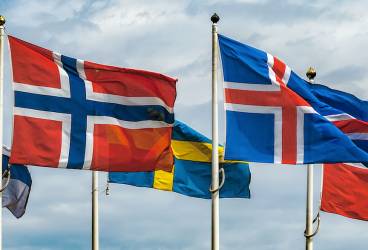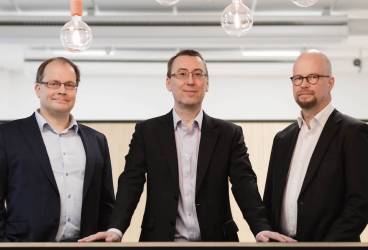Erillisverkot’s first Mission Critical Top Tech Trends survey published

Mission Critical Top Tech Trends 2021
Erillisverkot interviewed key ICT decision-makers in the public and private sectors in the spring of 2021. Interviews were conducted to identify the key technologies and trends for the future. The interviewees emphasised the importance of artificial intelligence, cloud services and 5G.
Finland has always been among the forerunners when comparing cooperation between the authorities and other security operators in different countries. Finns have also long enjoyed international excellence in the use of technologies that support cooperation.
Currently, many of the authorities’ technology solutions are based on separate, highly mature and tried and tested technologies. However, this development is moving in a new direction: in the future, the technological solutions of security operators will not be isolated from each other, but will increasingly overlap, intertwine or converge. The increasing interdependence of technologies is complicating the environment. On the other hand, the authorities and other security operators benefit from the development efforts of the consumer and business segments – innovations can also be introduced to serve the security operators.
5G: Increasing capacity and short delays in authority operations create new opportunities
Mobile networks are developing rapidly both in Finland and globally. By the end of the decade, the 5G network will be the platform on which our entire society functions.
GSMA, representing the interests of mobile operators worldwide, estimates that 5G services will reach up to one third of the world’s population by the end of 2025. Finland is clearly ahead of the global average trend: at the moment, 5G services already reach almost half of the population. In the early years, the introduction of 5G will mostly translate into more available capacity as the core net-work services continue running on 4G. All commercial operators currently offer 5G connections mainly for residential and business use as a substitute for a fixed broadband.
Capacity growth alone will have little impact on consumer usa patterns, as comprehensive 4G services are already available. In consumer services, the change is therefore mainly visible in various entertainment services. The services of the authorities and security operators are also developing in the wake of consumer expectations and wishes, as the security operator segment is too small to drive technological development globally on its own.
Increasing capacity and shorter delays create new opportunities. For example, situational awareness and management can be enhanced with data from multiple data streams, such as real-time high quality video. On the other hand, only when services are 5G ‘end-to-end’ also in terms of the core network will they start to have a significant impact on the authorities’ policies. This enables services such as remote control, robotics and enriched reality, which require a very low latency. At the same time, the development of mobile technology offers a safer and more secure working environment for the authorities. Such services are also part of the broadband Virve of the future.
End-to-end managed cloud solutions have the greatest overall benefit for security operators
From a technological point of view, the cloud is no longer a new opening, but its benefits have not yet been fully embraced. Clouds are still considered, at least in part, to be a technology of the future, even though services have already been available for years.
In order for 5G services to develop, cloud services, in addition to 4G or 5G connections, are needed as the location of applications. And, in order for the promised low latency of 5G services to materialise, the new radio network technology alone will not suffice. The entire ecosystem structure will have to be renewed. This means taking the services to where the users are. Decentralised architecture and edge computing solutions are critical elements in the design of the authorities’ operational information systems, and they were also featured strongly in the ICT decision-maker interviews carried out by Erillisverkot. So, will every base station have a data centre? Not in the foreseeable future. However, mobile network and cloud technologies will be one in the future, and architectures must match customers’ use cases.
The cloud is a challenging concept for the authorities, as a significant part of the information of authorities and security operators is such that it cannot be handled in a public cloud. The location of the data to be processed and the necessary integration points outside the national borders also raise questions. Erillisverkot is responding to this demand with a highly available secure cloud service, separate from the internet.
In addition to increasing cost-effectiveness, the cloud enables many new services that can be utilised in authority operations. The cloud can be used to build services required by different artificial intelligence (AI) and data analytics solutions. An example is data pools for storing data, which is handled by different algorithms according to the given instructions.
For authorities and security operators, AI provides first and foremost support for decision-making and opportunities for more efficient operations. Examples of AI solutions used by the authorities include area or forest fire monitoring solutions based on automated image recognition technologies.
When it comes to the operational activities of authorities and AI, various augmented reality solutions – such as smart glasses – often appear as the first use cases. Smart glasses are not a new invention: the first devices from Google and Microsoft were launched years ago. The data communication and cloud solutions implemented as an end-to-end managed entity support widely the operations of smart glasses and other devices and services, so that their implementation is also practically possible among security operators. It says something about the maturity of the technology that the U.S. Army and Microsoft recently signed a ten-year, $20 billion contract for the supply of more than 120,000 augmented reality wearables.
Developing Low Earth Orbit satellite services (LEO) will secure terrestrial networks and provide better geographic coverage of end-user services
From the point of view of security authorities, one interesting development is the wider use of so-called low earth orbit (LEO) satellites. When compared to higher orbit satellite solutions, these satellites provide a global communications service with high speed and significantly lower latency.
LEO satellites provide the technical capability to build truly global services – covering even the polar regions. Traditional geostationary satellite services have not reached the northernmost Finland, but due to the low orbit satellites, this will change. Another significant change is the wider use of satellite services in a variety of mobile solutions, such as vehicles and ships.
Satellites are also becoming an integral part of the mobile communications ecosystems, as the 3GPP organisation, which produces mobile technology standards, has incorporated satellite services as one of the types of access networks into 5G development. One interesting piece of news is Apple’s latest iPhone feature, which allows your phone to use the LEO satellite service to deliver at least short messages in an emergency.
In addition to telecommunications satellites, society’s security depends on the Global Navigation Satellite System (GNSS) satellites that produce time and space data. The precise data produced by satellite navigation systems secures official duties as well as the electricity grids, banking services and telecommunications network. The automation of traffic, for example, requires accurate, reliable and verified location and time synchronisation data.
By 2024, Finland will start using Galileo PRS (Public Regulated Services), a location and time data service that fulfils the requirementsof public safety organizations. Finnish Transport and Communications Agency Traficom is responsible for the service. Erillisverkot acts as a Galileo PRS service operator.
“As the technical environment becomes more complex, so does the ecosystem that provides services”
Challenges and opportunities often go hand in hand. While new technologies offer many interesting opportunities, exploiting rapidly evolving technologies is also extremely challenging.
The characteristics of the authorites’ work, such as the classification and protection of information, often pose an additional challenge to service development, but the seamless interaction of the aforementioned technology solutions makes it possible to take these needs into account as a natural part of the overall service. As the technical environment becomes more complex, so does the ecosystem that provides services. Erillisverkot’s own role in the ICT field is increasingly developing in the direction of the integrator. A good partner network is needed in this role.
The survey is based on Erillisverkot’s own assessment, spring 2021 stakeholder interviews, active monitoring of technological developments and dialogue with authorities and other security operators.
In the future, the Mission Critical Top Tech Trends survey will be published twice a year and will open technology perspectives on a more accurate level from a specifically selected perspective.
Mission Critical Top Tech Trends 2021 (pdf)
Further information:
Antti Kauppinen, CTO, +358 (0)40 866 8582, antti.kauppinen@erillisverkot.fi
Katariina Salmisalo, Director Of Communications, +358 (0)40 701 6576, katariina.salmisalo@erillisverkot.fi






